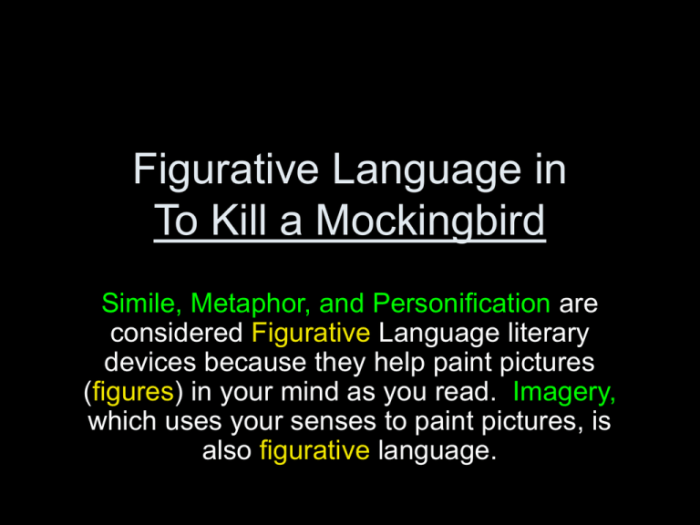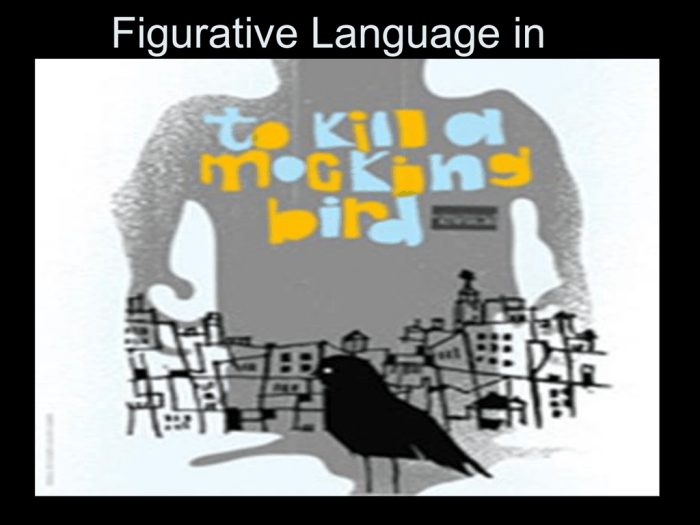Figurative language from to kill a mockingbird – Figurative language in Harper Lee’s “To Kill a Mockingbird” plays a pivotal role in shaping the novel’s characters, setting, and themes. Through the skillful use of similes, metaphors, personification, and other literary devices, Lee immerses readers in the complex world of Maycomb County, Alabama, and its inhabitants.
The novel’s rich figurative language enhances the reader’s experience by creating vivid imagery, conveying deeper meanings, and foreshadowing events.
Figurative Language in To Kill a Mockingbird: Figurative Language From To Kill A Mockingbird

Figurative language plays a crucial role in shaping the narrative, characterization, and themes of Harper Lee’s classic novel, To Kill a Mockingbird. Through the skillful use of similes, metaphors, personification, symbolism, and other literary devices, Lee creates a vivid and immersive world that resonates deeply with readers.
Similes and Metaphors
Lee employs similes and metaphors to create vivid comparisons and evoke strong emotions. For example, Scout’s description of Boo Radley as “a giant chicken” conveys both his physical appearance and her initial fear of him. Similarly, Atticus’s metaphor of the mockingbird as a symbol of innocence and vulnerability underscores the novel’s central theme of racial injustice.
Personification and Symbolism, Figurative language from to kill a mockingbird
Personification brings inanimate objects to life, enhancing the novel’s emotional impact. For instance, the “old house” where Boo Radley lives is described as having “a mysterious voice” that adds to the character’s enigmatic nature. Symbolism is also prevalent throughout the novel.
The mockingbird, as mentioned earlier, symbolizes innocence and vulnerability, while the oak tree represents strength and endurance.
Imagery and Sensory Language
Lee’s use of sensory language creates a rich and immersive reading experience. She appeals to the senses of sight, sound, smell, taste, and touch to evoke vivid images and emotions. For example, the description of the “hot, still summer” captures the oppressive atmosphere of the novel’s setting.
Irony and Foreshadowing
Irony and foreshadowing contribute to the novel’s dramatic tension and suspense. For instance, the irony of Boo Radley being a harmless recluse despite his menacing reputation adds to the novel’s exploration of prejudice. Foreshadowing, such as the repeated references to Tom Robinson’s trial, hints at the tragic events to come.
Hyperbole and Understatement
Hyperbole and understatement are used to emphasize emotions and ideas. Hyperbole, such as Scout’s claim that “Atticus Finch was the best man who ever lived,” expresses her deep admiration for her father. Understatement, as in Miss Maudie’s description of the Radley place as “quiet as a graveyard,” conveys the sense of isolation and mystery surrounding the property.
Figurative Language in Characterization
Figurative language plays a significant role in developing and revealing the characters. Similes and metaphors highlight their traits and motivations. For example, Scout’s comparison of Miss Maudie to “a polite crab” suggests her sharp wit and protective nature.
Figurative Language in Setting and Atmosphere
Lee’s use of figurative language creates a vivid sense of setting and atmosphere. Imagery and sensory language evoke the hot, humid climate and the racially charged environment of the novel. For instance, the description of the “dark shadows” that follow Tom Robinson home conveys the fear and prejudice he faces.
Figurative Language in Theme and Message
Figurative language reinforces the novel’s themes and messages. Symbolism, such as the mockingbird and the oak tree, conveys the themes of innocence, vulnerability, and resilience. Metaphors and similes, like Atticus’s comparison of prejudice to “a disease,” highlight the novel’s critique of social injustice.
FAQ
What is the significance of similes in “To Kill a Mockingbird”?
Similes in the novel draw comparisons between seemingly dissimilar things, creating vivid imagery and highlighting key characteristics of characters and situations.
How does personification contribute to the novel’s characterization?
Personification in “To Kill a Mockingbird” humanizes abstract concepts and inanimate objects, giving them human qualities and motivations, thereby enhancing the reader’s understanding of the characters and their interactions.
What is the role of symbolism in conveying the novel’s themes?
Symbols in the novel represent deeper meanings and ideas, enriching the narrative and allowing readers to draw connections between the characters, events, and the broader themes of justice, prejudice, and the loss of innocence.



